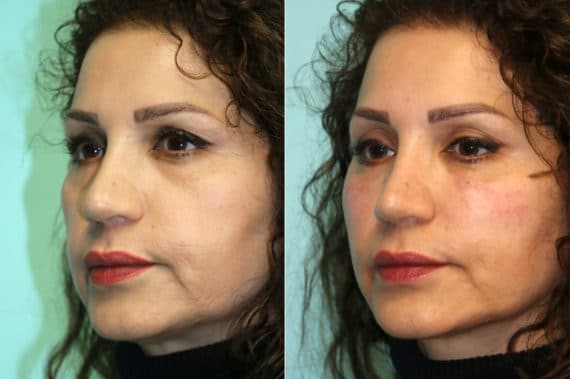There are patients in Virginia and Maryland who ask us: “Do I need filler or do I need a facelift?” when they see hollows under the eyes, loose skin on the jawline, or deep folds around the mouth. At The Naderi Center, Dr. Jessica Kulak, a board-certified facial plastic surgeon, guides patients through this choice daily. Each option works for certain goals. Knowing how the two differ helps patients avoid disappointment and achieve results that endure.

Deciding What’s Best for Your Face
- Dermal fillers are a good solution for non-surgical treatment of volume loss and early wrinkles.
- A facelift works wonders when it comes to saggy skin and deep creases that only fillers won’t be able to manage.
- Fillers are temporary solutions, whereas a facelift gives a permanent rejuvenation effect of up to ten years or more.
- At The Naderi Center, our experts guide each patient in selecting the best option by considering their individual anatomy and aspirations.
- The use of fillers along with facelift surgery and skin treatments can result in the most natural, harmonious, and durable outcomes.
Understanding What Dermal Fillers Do
Dermal fillers are injectable treatments designed to restore lost volume, smooth wrinkles, and enhance features. They are most commonly made of hyaluronic acid, a substance naturally found in the skin, which attracts water and plumps tissues. For patients who want a non-surgical refresh, fillers are an excellent option—though they come with limitations.
Common Areas for Filler Injections
At The Naderi Center, fillers can be placed in the cheeks, under-eye hollows (tear troughs), temples, lips, marionette lines, nasolabial folds, jawline, and chin. Each area requires a tailored approach and an expert injector, like ours, who understands both anatomy and artistry.
How Long Do Fillers Last?
The longevity of fillers depends on the product used and the area injected. On average, fillers last 6 to 18 months. Thicker fillers placed in the cheeks or jawline may last closer to two years, while lip fillers often last less than a year due to constant movement in the area.
Maintenance Timeline for Fillers
Patients who want consistent results with fillers should plan on touch-ups every 6–12 months. This helps maintain a natural, youthful appearance without dramatic fluctuations.
When It’s Too Late for Fillers
Fillers stop looking natural once the skin has loosened too much. Extra filler at that point swells the face, pulls features out of shape or gives an overfilled appearance. Once that happens, a facelift at The Naderi Center for Plastic Surgery restores a natural contour better than any injection.
The Limits of Fillers
Fillers add volume but do not tighten loose skin. They do not smooth the lines, crepey areas or folds that gravity has pulled downward. For those problems, a facelift performed by Dr. Kulak is usually the most effective solution.
The Role of Facelifts
A facelift addresses sagging skin and deep facial folds by repositioning underlying tissues and removing excess skin. Unlike fillers, a facelift directly treats laxity, restoring youthful contours in a way no injection can replicate. Patients from across Washington, D.C., Potomac, Chevy Chase, and Bethesda travel to The Naderi Center for this advanced procedure.
Longevity of Facelift Results
Facelifts typically last 10 years or longer, making them a long-term investment. While fillers require repeat visits and ongoing expense, a facelift at The Naderi Center offers a single procedure with results that last a decade or more.
Recovery from a Facelift
Most patients need about two weeks of recovery before returning to normal activities. Bruising and swelling are expected initially but gradually subside. Within a month, patients often feel confident returning to social events.
Combining Facelifts with Other Cosmetic Procedures
One advantage of surgery is that it allows additional procedures during the same operation. At the Naderi Center for Plastic Surgery and Dermatology, our specialist can add neck lifts, eyelid surgery, brow lifts and skin resurfacing to a facelift, so the whole face regains a more youthful appearance.
Fillers After a Facelift Surgery
A facelift does not stop a person from later having filler injections. Fillers plump the lips, soften lines or add small amounts of volume where the operation did not. Surgery and fillers fit together well.

Get honest, personalized guidance
Book your consultation with our specialists at Chevy Chase and Reston, and discover what’s right for your face.
Comparing Fillers vs. Facelifts
Understanding how these two treatments differ helps patients choose the best path for their individual needs.
Natural Results with Fillers
When performed conservatively by an expert, fillers can look natural and refreshed. The key is subtlety and balance. Overfilling leads to the “pillow face” look that patients want to avoid, which is why patients seek out the expertise of The Naderi Center.
Natural Results with Facelifts
Facelifts have evolved significantly. Today’s techniques focus on restoring natural contours, not pulling the skin tight. Patients trust Dr. Kulak for facelift results that look refreshed, never artificial.
Who is a Candidate for Fillers?
Fillers are best for patients in their 30s to 50s with mild to moderate volume loss and early signs of aging, but without significant sagging skin. Many patients start with injectables before moving to surgery.
Who is a Candidate for a Facelift?
Facelifts are best for patients in their 40s, 50s, 60s, and beyond who have moderate to severe laxity, jowls, or deep facial folds that fillers can no longer correct. Dr. Kulak helps patients across the region make this transition, including those traveling from McLean, Great Falls, Arlington, Alexandria, and Vienna for her expertise.

The Cost Factor
Fillers appear cheap at first. Each visit, however, costs money. After ten years, the total spent on repeat injections often surpasses the price of a facelift. For many patients, surgery becomes the cost-effective option in the long run.
Skin Quality vs. Volume
A facelift repositions tissues but does not improve skin quality. Patients with sun damage or fine wrinkles may benefit from lasers or resurfacing in addition to surgery. Fillers, likewise, don’t change skin health—they only add volume.
Risks and Safety
Every surgical or non-surgical treatment involves some danger. A provider who has performed many procedures will keep the chance of harm low and will produce predictable outcomes.
The Risks of Fillers
Like any medical procedure, fillers have possible side effects. The most common are bruising, swelling, and temporary asymmetry. Not very often, if a blood vessel is obstructed the filler may cause vascular occlusion. The selection of an expert injector at The Naderi Center not only reduces risks but also takes care of the whole procedure in a safe manner.
The Risks of Facelifts
Although facelifts are surgical procedures, they are regarded as safe if done by a skilled doctor. The risks involved in facelifts, such as scarring, temporary loss of sensation, or the development of blood clots, are significantly reduced if the surgeon is experienced and operates in accredited facilities like The Naderi Center.
Why Experience Matters
Both fillers and facelifts require expertise. A poorly placed filler can distort features, while an inexperienced surgeon can create unnatural facelift results. Choosing a board-certified facial plastic surgeon like Dr. Kulak is the safest and most reliable choice.
Making the Right Decision
A useful plan matches your body structure, age and long-term goals.
The Problem with Medspas
Many medspas only offer injectables, not surgery. This means patients who truly need a facelift are often steered toward more filler instead of being referred out to a surgeon. The result can be overfilled, unnatural appearances and patient dissatisfaction.
How to Avoid Disappointment
Choose a doctor who offers both surgical and non-surgical treatments. At the Naderi Center, our experts review each patient alone and select the treatment that fits best. They don’t limit the choice to procedures that the clinic itself supplies.
How Dr. Jessica Kulak Approaches the Decision
Dr. Kulak reviews the shape of the face, the tightness of the skin, age and what the patient wants to achieve. She gives clear advice, even if that means suggesting surgery over fillers—or vice versa. The Naderi Center keeps this focus on the patient’s real needs and which makes it different.
The Psychological Side of Aging
Patients often say they feel younger and more confident after fillers or a facelift. The chosen treatment gives back a refreshed look, as well as raising self-esteem. People talk more easily with others and join social events without hesitation because their renewed appearance boosts confidence.
The Naderi Center Difference
At The Naderi Center, every doctor works only in the field they know best. Dr. Kulak limits her work to facelifts and facial rejuvenation. She gives patients surgical choices as well as non-surgical ones. Each patient gets a plan tailored to them for results that look natural and last for years.
Schedule your consultation here.
Frequently Asked Questions
How long does a facelift last compared to fillers?
A facelift gives a result that stays visible for at least ten years. Fillers, six to eighteen months.
Can fillers replace a facelift?
No. Fillers only add volume—they do not lift skin that has started to droop or has become loose.
Is recovery from a facelift difficult?
Many people clear two weeks off their usual schedule. Pain is kept under control with tablets prescribed by the surgeon. Improvements become clearer week by week during the first month.
Can I still get fillers after a facelift?
Yes. After surgery, patients often keep using fillers for the lips, for fine lines, or to restore slight fullness.
When should I stop getting fillers and consider a facelift?
When fillers no longer smooth the skin or restore lost volume in a way that appears natural or they create a bloated appearance instead of rejuvenation, it is time to discuss surgical options with our specialist at The Naderi Center.
Why shouldn’t I just go to a medspa for fillers?
A medspa that does only injections can sell filler to you even though a facelift is the correct choice—this can yield an unnatural look. When you consult a facial plastic surgeon at The Naderi Center for Plastic Surgery and Dermatology, you receive advice on every option before a plan is chosen.
Are there non-surgical treatments that can complement fillers or a facelift?
Absolutely. Skin resurfacing, laser treatments, or chemical peels can improve skin tone and texture, while Botox® can smooth dynamic wrinkles. Our surgeon often combines these treatments for balanced, natural rejuvenation.

